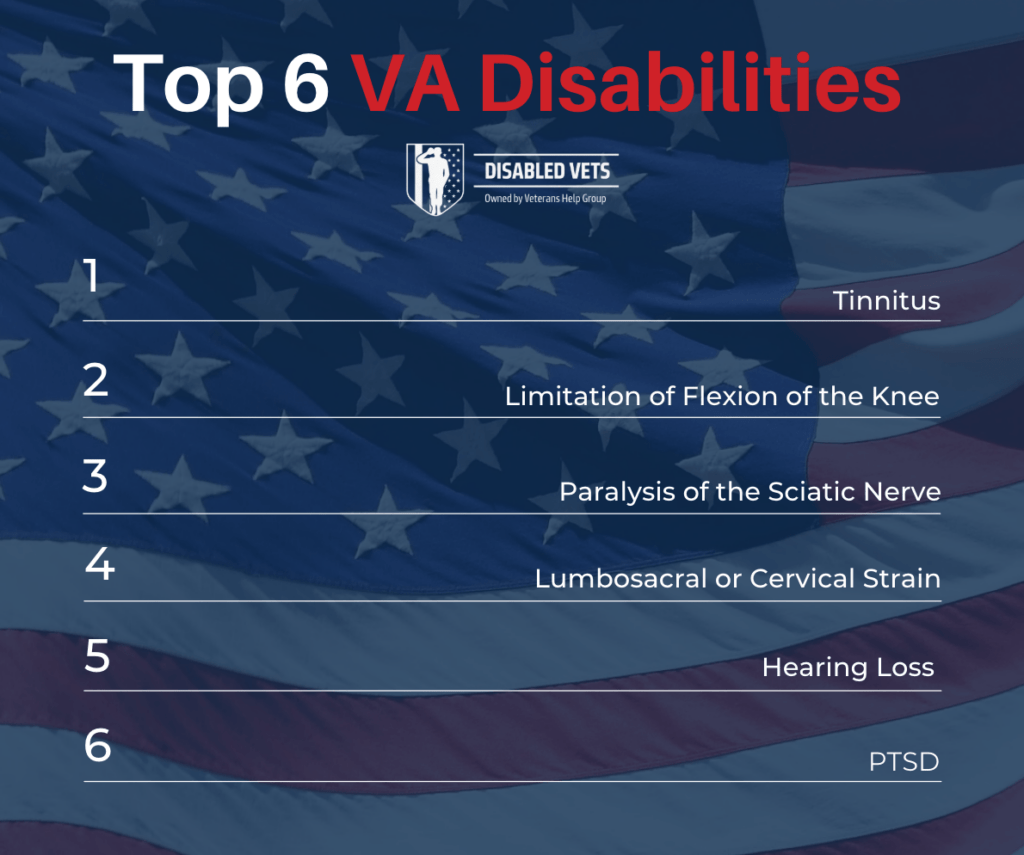
Most Common Veteran Disabilities and How They are Rated
Each year, the VA reports on the top conditions veterans are receiving VA disability benefits for. But, if you’re receiving veterans disability benefits or are considering filing a claim, you know that benefits vary significantly. The amount of monthly compensation you receive, and your access to non-monetary benefits such as medical care, depends on your VA disability rating.
With that in mind, it’s important to know how the VA rates common conditions, and what the differences in those ratings can mean for you as a disabled veteran. It’s also important to understand that the rating criteria may be technical and complex and that there may be circumstances where a veteran is entitled to extra-schedular rating.
Working with an experienced veterans disability benefits advocate from the beginning can eliminate the unknowns, reduce stress, and help avoid simple mistakes or omissions that can delay a claim or result in denial.
Top 6 VA Disabilities in 2024

1. Tinnitus
Tinnitus is by far the most common condition veterans receive disability benefits for. In 2024, 3,255,323 U.S. military veterans were receiving disability benefits for tinnitus. That number is more than 1 million higher than the next most common condition. That count is increasing rapidly. In 2024, more than 273,000 new recipients started receiving veterans disability benefits for tinnitus.
However, tinnitus is different from most conditions veterans receive benefits for, in that only one VA disability rating is possible. A veteran with service-connected tinnitus is entitled to a 10% disability rating. That’s true regardless of severity, and regardless of whether it’s in one ear or both. A veteran with a disability rating for tinnitus can have a higher combined rating if they suffer from one or more other service-connected conditions. And, a very small percentage of veterans with tinnitus have been assigned an extra-schedular rating. However, the rating schedule for the condition contains only the 10% rating.
A proposed rule change that could take effect as early as 2025 would eliminate standalone VA disability ratings for tinnitus.
2. Limitation of Flexion of the Knee
Limited flexion of the knee comes in second, with 2,069,942 veterans receiving disabled veterans’ benefits for the condition in 2024. That same year, 153,205 new recipients started getting VA disability for the limited flexion of the knee.
With most conditions, there’s one rating schedule. If benefits are to be awarded, it will either be based on that schedule or due to an extraschedular determination. Knee flexion (and also hip flexion) conditions are a bit different. Under 38 CFR §4.71a, knee flexion conditions are to be evaluated under whichever of four different schedules yields the highest rating.
These differing listings also offer different ranges of disability ratings. On two of these schedules, the lowest possible rating is 0%. The top ends of the schedules range from 30% to 60%.
3. Paralysis of the Sciatic Nerve
As of the most recent report, 1,745,314 veterans were receiving VA disability benefits for paralysis of the sciatic nerve. However, just 86,121 new claims for this condition were approved in 2024, dropping the condition to # 7 on the list of newly-approved disabilities.
Paralysis of the sciatic nerve is evaluated under 38 CFR §4.124a. The rating depends on the degree of paralysis, as follows:
- Mild – 10%
- Moderate – 20%
- Moderately severe – 40%
- Severe with marked muscular atrophy – 60%
- Complete – 80%
4. Lumbosacral or Cervical Strain
In 2024, lumbosacral and cervical strain moved up to # 4 for all recipients of VA disability benefits, with a total of 1,611,188 veterans wholly or partly disabled by one of these conditions. That includes 132,617 new claims approved in 2024. These conditions are rated under the General Rating Formula for Diseases and Conditions of the Spine.
The ratings are based on the degree and nature of immobilization of the spine. Possible ratings are 10%, 20%, 30%, 40%, 50%, and 100%. At the lower end of the rating scale, there are multiple ways a veteran can qualify for that rating. However, at the higher end, the requirements are narrower. A 50% rating is assigned for unfavorable ankylosis of the entire thoracolumbar spine. A 100% rating is only assigned when the veteran has unfavorable ankylosis of the entire spine.
5. Hearing Loss
Hearing loss is common among veterans, due mostly to the noise exposure associated with firearms and machinery used in training, combat, and even many other military roles. In 2024, 1,594,271 veterans were receiving VA disability benefits for hearing loss. 108,105 of them were new recipients.
The VA determines disability ratings for hearing loss through a very specific process. Two specific tests are required and must be administered by a licensed audiologist. The two required tests are the Maryland CNC test and the Pure-Tone audiometric test. The VA then uses a grid system to determine the appropriate disability rating, with possible ratings ranging from 0% to 100%. A veteran with a 100% disability rating due to hearing loss may be entitled to Special Monthly Compensation.
6. Post-Traumatic Stress Disorder (PTSD)
Post-traumatic stress disorder is by far the most common mental health condition veterans receive VA disability benefits for. In 2024, 1,589,833 former members of the military received disabled veteran benefits for PTSD. Though the condition has dropped down the list in terms of most common new claims across the past several years, the raw number of new recipients has continued to increase. In 2024, 81,968 veterans successfully claimed VA disability benefits for post-traumatic stress disorder.
PTSD is rated on the General Rating Schedule for Mental Disorders. The rating for PTSD and other mental health conditions depends on the degree of social and occupational impairment, with possible ratings of 0%, 10%, 30%, 50%, 70% and 100%. At the low end, a 0% rating is assigned when the veteran has been diagnosed with PTSD, but symptoms are not serious enough to impair social or occupational function and continuous medication is not required. At the other end of the spectrum, a 100% rating is assigned for total social and occupational impairment.
Additional Common Conditions for VA Disability
The following conditions round out the top 10 conditions former service members receive VA disability benefits for:
- Limitation of motion of the arm (1,200,103 total recipients with 115,597 new claims approved)
- Limitation of motion of the ankle (1,142,492 total recipients with 85,947 new claims approved)
- Scars and burns (1,125,720 total recipients with 96,578 new claims approved)
- Migraine (1,109,254 total recipients with 83,992 new claims approved)
Get the Help You Need with a VA Disability Claim
Whether you’re seeking veterans disability benefits for one of these common conditions or another disability, it’s important to submit the strongest possible claim. If you’re appealing a denial or attempting to raise your disability rating or receive TDIU classification to increase your benefits, it’s important to know what type of evidence the VA will be looking for.
At Disabled Vets, our advocates are fully dedicated to helping disabled veterans and their families get the benefits they deserve. We have extensive experience with the VA disability claims and appeals processes. To learn more about how we can put that experience to work for you, call (888) 373-4722 right now, or fill out our contact form here.



